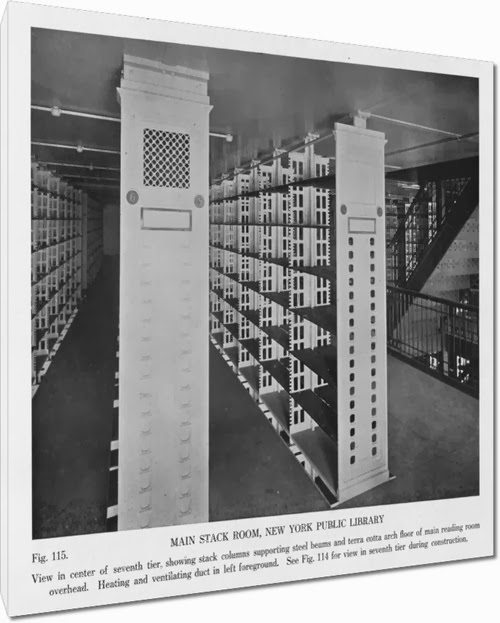Yesterday I was invited to tour the stacks at the 42nd Street Library as part of a delegation from the PEN American Center, which the NYPL is hoping to win over to its cause. The purpose of the tour was to convince us that the demolition of the stacks is necessary and a contribution to service and scholarship. What I saw convinced me of the opposite.
 |
| Before the removal of the books |
We were led through a floor of the stacks that once held 3 million books directly below the Rose Reading Room, making it possible for a book to be delivered to a library user minutes after it was requested. The rows and rows of empty stacks were a sad sight. There was also a striking discrepancy between what we were seeing and the talking points that our hosts, Chief Library Officer Mary Lee Kennedy and Vice President of Communications and Marketing Ken Weine, kept repeating as we walked. What they said was: Look what bad shape the stacks are in, and before we removed the books you would smell a terrible smell down here: “the smell of the books dying” (Kennedy). This has been a talking point NYPL CEO Anthony Marx has been repeating for months now: the claim that the library “had no choice” but to remove the books from the stacks a year ago because the books were “rotting” on the shelves. I don’t know anyone not in the employ of NYPL who believes that this is true.
 The stacks I saw yesterday were pretty dusty, and that was the only thing obviously “wrong” with them. I saw not a trace of rust on the sturdy and elegant Carnegie steel stacks (manufactured from a grade of steel that isn’t made anymore), and the marble floors holding up the stacks—which also structurally support the Rose Reading Room above—appeared to be in excellent shape. A sprinkler system snaked along the ceiling, accompanied by vents for the HVAC system. Another NYPL talking point is that the stacks cannot be appropriately climate-controlled; well, a state-of-the-art climate-control system was installed in the stacks in the 1980s. I’m sure it’s due for an upgrade thirty years later. And upgrading it would certainly be cheaper than tearing out seven floors of stacks and reengineering the entire building so that the Rose Reading Room won’t collapse when its supports are removed.
The stacks I saw yesterday were pretty dusty, and that was the only thing obviously “wrong” with them. I saw not a trace of rust on the sturdy and elegant Carnegie steel stacks (manufactured from a grade of steel that isn’t made anymore), and the marble floors holding up the stacks—which also structurally support the Rose Reading Room above—appeared to be in excellent shape. A sprinkler system snaked along the ceiling, accompanied by vents for the HVAC system. Another NYPL talking point is that the stacks cannot be appropriately climate-controlled; well, a state-of-the-art climate-control system was installed in the stacks in the 1980s. I’m sure it’s due for an upgrade thirty years later. And upgrading it would certainly be cheaper than tearing out seven floors of stacks and reengineering the entire building so that the Rose Reading Room won’t collapse when its supports are removed.
The PEN delegation also toured BPSE (pronounced “bipsy”), the Bryant Park Stack Extension: two floors of concrete basement built beneath the park in the 1980s. The first basement floor is climate controlled and equipped with enormous moving bookshelves on tracks to maximize the storage space. Currently these shelves house 1.2 million books. NYPL is now planning to equip the lower level of BPSE—currently just a concrete shell—with an HVAC system and shelves, which if the space can indeed hold the same amount of shelving as the space upstairs (the ceilings downstairs looked a bit lower to me), will allow BPSE to house a total of 2.4 million volumes.
Now let’s do the numbers. During the tour, Kennedy said that after the proposed renovation over 80% of the books formerly housed in the stacks would remain onsite. Here’s a more accurate version of the facts and figures presented by NYPL CEO Tony Marx back in 2012, before the library had retained a PR firm to help it refine its talking points:
What will happen to the books at 42nd Street? Marx said that there are now about 3 million books in the stacks, 1.2 million in the Bryant Park Stack Extension (BPSE), and 300,000 to 400,000 stored elsewhere in the building. He said that 4 million volumes are now stored offsite. After the CLP [Central Library Plan renovation], at least 2 million books would remain onsite, mostly in BPSE.
In short: with the stacks, a total of 4.5 to 4.6 million books onsite. Without the stacks and with a new second floor of BPSE: 2.7 to 2.8 million books onsite. But if NYPL also goes ahead with its plan of consolidating the Mid-Manhattan Library and the Science, Industry and Business Library (SIBL) in a new lending library contained within the 42nd Street Building, that will mean another 1 million books (the size of the combined collections of those two libraries) that will have to be housed somewhere, probably displacing even more books from the research collection to NJ.
A year and a half ago, NYPL Trustee Abby S. Milstein and her husband, real estate developer Howard P. Milstein, donated $8 million to the library to build out the stacks in the second level of BPSE. If this renovation is completed without demolishing the stacks, this would permit the library to house an awe-inspiring 5.7 to 5.8 million books onsite. Now that would be a place to get some serious research done.
Meanwhile the book delivery system that transports books from deep storage in NJ to 42nd Street remains plagued with problems. Just this week, Pulitzer Prize winning biographer Annalyn Swan reported experiencing a two-day lag between requesting a book and getting an email saying that it was “in the process of being delivered”—which meant an extra day or two for it actually to be delivered and available on site. I doubt it’s possible that the library will ever be able to deliver books from offsite storage within 24 hours, as its publicity materials promise. When I asked Mary Lee Kennedy if she knew what could be causing delivery problems of the sort experienced by Swan, she said that the closing of traffic around Times Square in preparation for this weekend’s Super Bowl had interfered with the ability of the trucks bringing books from NJ to get near the library. So the books had to be delivered instead to a remote location and then brought in smaller shipments to 42nd Street. The Super Bowl probably won’t be striking in our area again for some time, but there are certainly enough other events that regularly restrict traffic in the vicinity of Times Square. Is anyone surprised that this might be a recurrent problem?
 There is also the issue of damage the research materials may sustain while being transported back and forth. Every book one requests now from deep storage has a long journey ahead of it, including a truck ride down the NJ Turnpike and loading and unloading on either end. Researchers who work with older materials (as do I) are familiar with the experience of having books delivered in fragile or damaged condition. Here’s one image of a book with a detached cover from the NYPL collection encountered recently by a Medievalist doing research there. Shipping a book like this back and forth to NJ is hardly going to improve its condition.
There is also the issue of damage the research materials may sustain while being transported back and forth. Every book one requests now from deep storage has a long journey ahead of it, including a truck ride down the NJ Turnpike and loading and unloading on either end. Researchers who work with older materials (as do I) are familiar with the experience of having books delivered in fragile or damaged condition. Here’s one image of a book with a detached cover from the NYPL collection encountered recently by a Medievalist doing research there. Shipping a book like this back and forth to NJ is hardly going to improve its condition.
After yesterday’s tour, I remain convinced that the plan to demolish the stacks has nothing to do with making the library a better library and everything to do with a grand real estate scheme involving the sell-off of the Mid-Manhattan Library and SIBL. The sale of the Donnell Library a few years ago was part of this same plan and is now pretty much universally believed to have been a debacle: The sale raised very little money for the library compared with the actual value of the property, and as a result of the transaction, this once thriving neighborhood library with five floors of books and a nice auditorium is being replaced by a mini-library housed in two basement floors of a hotel tower, with very little room for books. This new neighborhood library will probably be a good place to check out DVDs and not much more.
 Even though NYPL has already applied for building permits to begin work on the demolition of the stacks as well as securing all the necessary state and local permissions, there is still no final plan or budget for the renovation. The most recent images released by the library show a vast atrium replacing the stacks, with seating areas to accommodate what looks to be between 100 and 130 people; given the structure of this open area, it is likely to be quite loud and not suitable for actual study, more a place to have coffee and chat with friends than somewhere to read and write. I asked Mary Lee Kennedy about the current status of the plan yesterday, and was told that it was still evolving and that she couldn’t reveal anything further about it. Although NYPL is a public institution, the plan has been shrouded in secrecy since its inception. In fact, there’s so much secrecy surrounding the plan and its progress that Kennedy and Weine forbade me to take any photographs of the stacks during the tour. Why not? I asked, this is a public institution, what the stacks look like shouldn’t be a secret. Weine referred me to the NYPL’s “policy” prohibiting photography in the library’s “non-public spaces.” When I asked where I could find a record of that policy, it quickly became clear there wasn’t one. I guess NYPL leadership is afraid that if enough people see actual images of the stacks in their current state—they give an impression simultaneously of vastness and solidity—they might have too many questions about why in the world the library is proposing to tear them down.
Even though NYPL has already applied for building permits to begin work on the demolition of the stacks as well as securing all the necessary state and local permissions, there is still no final plan or budget for the renovation. The most recent images released by the library show a vast atrium replacing the stacks, with seating areas to accommodate what looks to be between 100 and 130 people; given the structure of this open area, it is likely to be quite loud and not suitable for actual study, more a place to have coffee and chat with friends than somewhere to read and write. I asked Mary Lee Kennedy about the current status of the plan yesterday, and was told that it was still evolving and that she couldn’t reveal anything further about it. Although NYPL is a public institution, the plan has been shrouded in secrecy since its inception. In fact, there’s so much secrecy surrounding the plan and its progress that Kennedy and Weine forbade me to take any photographs of the stacks during the tour. Why not? I asked, this is a public institution, what the stacks look like shouldn’t be a secret. Weine referred me to the NYPL’s “policy” prohibiting photography in the library’s “non-public spaces.” When I asked where I could find a record of that policy, it quickly became clear there wasn’t one. I guess NYPL leadership is afraid that if enough people see actual images of the stacks in their current state—they give an impression simultaneously of vastness and solidity—they might have too many questions about why in the world the library is proposing to tear them down.


This is wonderful work. One point on the calculations about how many books there could be vs the impoverishing planned-
Regarding if BPSE were fully built out- My earlier calculations were that if BPSE were built out that even more books would be in the library than written above.
The historic and fabled stacks toured hold 3 million. BPSE was built to hold 3.2 million. That’s at least 6.2 million books. The rest of the Central Reference Library has spaces that used to hold another 352,000 or more additional books- That’s about 6.552 altogether.
See my calculations and information here.
Wednesday, November 27, 2013
Are NYPL Trustees Flying Blind on The Basics? Numbers To Inform Them About The Drastic Dwindling of Books In Manhattan’s Principal Libraries Are Missing From Their Minutes
http://noticingnewyork.blogspot.com/2013/11/are-nypl-trustees-flying-blind-on.html
I also write there about how with other subtractions we are going down from perhaps 13 million books at Manhattan’s flagship destination libraries to, what four million? Fewer?
Does the Superbowl explain why a book I requested 25 Jan ’14 was not available until 29 Jan? The counter that day was filled with other researchers inquiring about why their books, ordered two days earlier had not yet arrived.
A book I requested via email on 25 Jan arrived finally on 29 Jan, which is to say, I was notified at about 11am that day — a little late for a full workday with the book. The counters were full of other researchers inquiring about missing/ non-delivered off-site books.
It seems really strange in our On Demand age that NYPL would think library patrons would be okay with a 24 hour delay, let alone four days. And the damage question is huge. Hope they’ve left room in the new design for an expanded Complaints Dept. Perhaps it’s all part of a new frontier in architecture.
Thank you for writing this article. The present leadership team at NYPL has been a debacle for serious users of the library.
The original stacks are part of an original overall design by Carrere and Hastings that should have been designated one of the rare interior landmarks in its entirety years ago. Moreover, they work quite well, and if NYPL hadn’t replaced so many qualified librarians with poorly paid assistants in recent years they would work even better. And the new spaces NYPL offers us, like the absurd staircase leading to the (perfectly decent) lecture room added at the main branch a few years ago evince a hackneyed, worn-out aesthetic in which considerable space is wasted on showy nothingness–see also the plans for the new Donnell.
A great read. Their plan to move books offsite makes no sense to me. I hope more and more public outcry will deter this move.